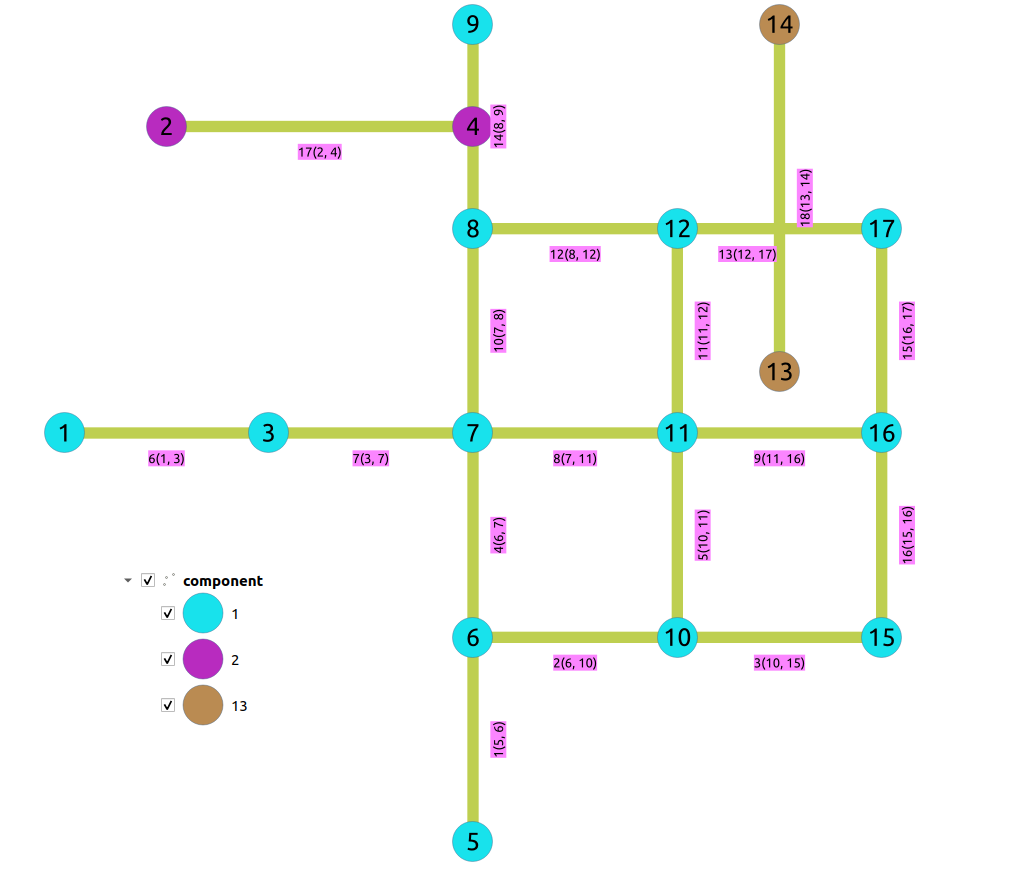Unsupported versions:2.6 2.5
pgr_connectedComponents¶
pgr_connectedComponents — Connected components of an undirected graph using
a DFS-based approach.
Availability
Version 3.0.0
Result columns change:
n_seqis removedseqchanged type toBIGINT
Function promoted to official.
Version 2.5.0
New experimental function.
Description¶
A connected component of an undirected graph is a set of vertices that are all reachable from each other.
The main characteristics are:
Works for undirected graphs.
Components are described by vertices
The returned values are ordered:
componentascendingnodeascending
Running time:
Signatures¶
(seq, component, node)- Example:
The connected components of the graph
SELECT * FROM pgr_connectedComponents(
'SELECT id, source, target, cost, reverse_cost FROM edges'
);
seq | component | node
-----+-----------+------
1 | 1 | 1
2 | 1 | 3
3 | 1 | 5
4 | 1 | 6
5 | 1 | 7
6 | 1 | 8
7 | 1 | 9
8 | 1 | 10
9 | 1 | 11
10 | 1 | 12
11 | 1 | 15
12 | 1 | 16
13 | 1 | 17
14 | 2 | 2
15 | 2 | 4
16 | 13 | 13
17 | 13 | 14
(17 rows)

Parameters¶
Parameter |
Type |
Description |
|---|---|---|
|
Edges SQL as described below. |
Inner Queries¶
Edges SQL¶
Column |
Type |
Default |
Description |
|---|---|---|---|
|
ANY-INTEGER |
Identifier of the edge. |
|
|
ANY-INTEGER |
Identifier of the first end point vertex of the edge. |
|
|
ANY-INTEGER |
Identifier of the second end point vertex of the edge. |
|
|
ANY-NUMERICAL |
Weight of the edge ( |
|
|
ANY-NUMERICAL |
-1 |
Weight of the edge (
|
Where:
- ANY-INTEGER:
SMALLINT,INTEGER,BIGINT- ANY-NUMERICAL:
SMALLINT,INTEGER,BIGINT,REAL,FLOAT
Result columns¶
Returns set of (seq, component, node)
Column |
Type |
Description |
|---|---|---|
|
|
Sequential value starting from 1. |
|
|
Component identifier.
|
|
|
Identifier of the vertex that belongs to the |
Additional Examples¶
Connecting disconnected components¶
To get the graph connectivity:
SELECT * FROM pgr_connectedComponents(
'SELECT id, source, target, cost, reverse_cost FROM edges'
);
seq | component | node
-----+-----------+------
1 | 1 | 1
2 | 1 | 3
3 | 1 | 5
4 | 1 | 6
5 | 1 | 7
6 | 1 | 8
7 | 1 | 9
8 | 1 | 10
9 | 1 | 11
10 | 1 | 12
11 | 1 | 15
12 | 1 | 16
13 | 1 | 17
14 | 2 | 2
15 | 2 | 4
16 | 13 | 13
17 | 13 | 14
(17 rows)
There are three basic ways to connect components:
From the vertex to the starting point of the edge
From the vertex to the ending point of the edge
From the vertex to the closest vertex on the edge
This solution requires the edge to be split.
In this example pgr_separateCrossing and pgr_separateTouching will be used.
Get the connectivity
SELECT * FROM pgr_connectedComponents(
'SELECT id, source, target, cost, reverse_cost FROM edges'
);
seq | component | node
-----+-----------+------
1 | 1 | 1
2 | 1 | 3
3 | 1 | 5
4 | 1 | 6
5 | 1 | 7
6 | 1 | 8
7 | 1 | 9
8 | 1 | 10
9 | 1 | 11
10 | 1 | 12
11 | 1 | 15
12 | 1 | 16
13 | 1 | 17
14 | 2 | 2
15 | 2 | 4
16 | 13 | 13
17 | 13 | 14
(17 rows)
Prepare tables
In this example: the edges table will need an additional column and the vertex table will be rebuilt completely.
ALTER TABLE edges ADD old_id BIGINT;
ALTER TABLE
DROP TABLE vertices;
DROP TABLE
Insert new edges
Using pgr_separateCrossing and pgr_separateTouching insert the results into the edges table.
INSERT INTO edges (old_id, geom)
SELECT id, geom FROM pgr_separateCrossing('SELECT * FROM edges')
UNION
SELECT id, geom FROM pgr_separateTouching('SELECT * FROM edges');
INSERT 0 6
Create the vertices table
Using pgr_extractVertices create the table.
CREATE TABLE vertices AS
SELECT * FROM pgr_extractVertices('SELECT id, geom FROM edges');
SELECT 18
Update the topology
/* -- set the source information */
UPDATE edges AS e
SET source = v.id, x1 = x, y1 = y
FROM vertices AS v
WHERE ST_StartPoint(e.geom) = v.geom;
UPDATE 24
/* -- set the target information */
UPDATE edges AS e
SET target = v.id, x2 = x, y2 = y
FROM vertices AS v
WHERE ST_EndPoint(e.geom) = v.geom;
UPDATE 24
Update other values
In this example only cost and reverse_cost are updated, where they are
based on the length of the geometry and the directionality is kept using the
sign function.
UPDATE edges e
SET cost = ST_length(e.geom)*sign(e1.cost),
reverse_cost = ST_length(e.geom)*sign(e1.reverse_cost)
FROM edges e1
WHERE e.cost IS NULL AND e1.id = e.old_id;
UPDATE 6
SELECT * FROM pgr_connectedComponents(
'SELECT id, source, target, cost, reverse_cost FROM edges'
);
seq | component | node
-----+-----------+------
1 | 1 | 1
2 | 1 | 2
3 | 1 | 3
4 | 1 | 4
5 | 1 | 5
6 | 1 | 6
7 | 1 | 7
8 | 1 | 8
9 | 1 | 9
10 | 1 | 10
11 | 1 | 11
12 | 1 | 12
13 | 1 | 13
14 | 1 | 14
15 | 1 | 15
16 | 1 | 16
17 | 1 | 17
18 | 1 | 18
(18 rows)
See Also¶
wikipedia: Connected component
Indices and tables
